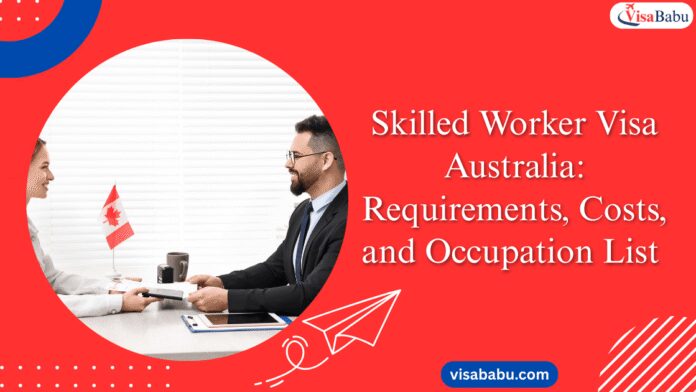Australia’s skilled migration rules have changed a lot in 2025, which means there are now more chances for people with skills to move to the country and work there. With the Skills in Demand visa and recent changes to other visa types, it’s important to have the latest information when applying for Australian immigration. Whether you’ve been working for a while, just finished school, or want to move Down Under with your family, this guide will help you understand everything you need to know about getting a skilled worker visa Australia.
With Australia’s changing skilled migration rules and new visa options coming in 2025, knowing what’s available can really help you make the right choice for your future. Let’s look at all the steps you need to take if you want to move and work in Australia.
What is a Skilled Worker Visa Australia?
A skilled worker visa australia is an immigration pathway that allows qualified professionals to live and work in Australia based on their skills, qualifications, and experience. These visas were made to help fill jobs that are in demand in Australia by inviting skilled workers from other countries.
The Australian government gives these visas so that workers from other countries can help when they are needed in some jobs and make sure the workforce keeps doing well. Unlike tourist or student visas, skilled worker visas let you stay longer and, in some cases, lead to getting permanent residency and eventually becoming a citizen.
Each type of skilled visa has its own set of rules you need to follow, things you can get, and things you are not allowed to do. Some require that an employer sponsor the worker, while others have a points-based system that looks at things like how old you are, your work experience, education, and how well you speak English.
The skilled migration program is an important part of Australia’s immigration policy, as it helps bring in workers who can contribute to the country’s economy, while also giving skilled professionals a chance to start fresh in a great place to live.
Latest Types of Australia Immigration Skilled Worker Visas
The immigration skilled worker visa Australia program offers several pathways for skilled professionals. Each visa category has its own way of helping someone enter Australia, depending on what they need to do.
Skilled Independent Visa (Subclass 189)
This visa is for workers who want to work in Australia on their own without a job offer or any family or government support. It’s a visa that gives you permission to live and work in Australia permanently.
Key features:
- Permanent residency from day one
- No sponsorship required
- Must get at least 65 points on the points test.
- Occupation must be on the list of skills the government recognises for workers coming to Canada.
Skilled Nominated Visa (Subclass 190)
This visa requires you to be nominated by one of the Australian state or territory governments. It’s similar to the Subclass 189, but you get extra points if you are nominated by a state government.
Key features:
- Permanent residency status
- Requires state/territory nomination
- An additional 5 points for nomination
- Moral obligation means that even if it’s not required by law, someone should consider living in the state they choose to run for office in.
Skilled Work Regional (Provisional) Visa (Subclass 491)
It is a type of temporary visa for skilled workers who want to live and work in regional Australia.
This provisional visa is for people with certain skills who want to live and work in regional areas of Australia. It means you need either support from the state or territory government, or a family looking after you in a certain part of the region.
Key features:
- Five-year provisional visa
- Requires living in a place that isn’t very large or crowded.
- The pathway to permanent residency after three years means that once you live in Canada for three years, you can apply to become a permanent resident.
- An additional 15 points for regional nomination
Skills in Demand Visa (SID, subclass 482)
It is an Australian work visa that allows skilled workers from overseas to live and work in Australia.
Introduced in December 2024, the new visa takes over where the old Temporary Skill Shortage visa used to be. It gives people who work in high-demand jobs in high demand up to four years to work in Canada, and helps them get citizenship more quickly.
Key features:
- Up to four years of work rights means you can legally work in Canada for that amount of time.
- Employer sponsorship required
- Pathway to permanent residency through the Employer Nomination Scheme means that a job offer from an Australian employer can support your application for a visa and help you get a chance to live and work in the country permanently.
- Streamlined application process
These visa options make it possible for skilled workers to decide what’s best for them: applying on their own, getting nominated by a state, choosing to live and work in a regional area, or being offered a job by an Australian employer.
Skilled Worker Visa Australia Eligibility Criteria: Updated Guide 2025
To qualify for a skilled worker visa in australia, you must meet several key eligibility requirements. The Australian government has a system where it looks at the skills and experience of people applying for most skilled visas and gives them points based on how well they meet the requirements.
General requirements include:
- Having a job that is on the list of skilled jobs that Australia needs is a must if you want to move to Australia.
- Getting a positive skills assessment for the job you want means showing the government that you have the right skills and experience for that role.
- Meeting the points threshold means getting at least 65 points out of the total 80 that are possible.
- Being under 45 years old is generally one of the requirements to get most of these visas.
- Meeting English language requirements
- Passing health and character checks
The specific requirements change depending on the type of visa you want to apply for. For employer-sponsored visas like the Skills in Demand visa, you’ll need to have a job offer from an employer who’s been approved by the Australian government.
For independent and state-nominated visas, you mostly need to have a certain number of points and show that your job is one that Australia wants more workers in.
Latest Points Test System Explained for Skilled Worker Visa Australia in 2025
The points test is an important part of Australia’s program for letting people in who want to migrate with skills. It looks at different things about the candidates to see which one is best fit for the job.
- Age: Maximum points (30) go to job seekers between the ages of 25 and 32, and the number of points goes down if you are younger or older than that.
- English language skills: Up to 20 points can be earned if you use clear, simple, and correct English.
- Work experience: Points for both Australian and overseas work experience in your nominated occupation are given separately, and you can get them if you have done similar work in other countries.
- Educational qualifications: Higher points for advanced degrees
- Australian study: Points for completing Australian qualifications
Additional points are available for:
- State/territory nomination
- Partner skills
- Professional year in Australia
- Specialist education qualifications
- Community language skills
- Regional Australia study experience
While the minimum score is 65, more people are applying to UCS, so you usually need a higher score to get in these days. This means you really need to get as many points as you can from the things you do.
Australia Skilled Worker Visa Job List: Latest Occupations in Demand 2025
The australia skilled worker visa list, officially known as the Skilled Occupation List (SOL), is a critical component of Australia’s immigration system. This list shows the jobs people are needed for in Australia and changes each year to keep up with what the job market needs.
In early 2025, the list was updated to help with new shortages of workers in important areas. The current list includes jobs from lots of different types of work, such as:
- Information Technology: Software developers, cybersecurity workers and data scientists are the main jobs you’ll find in this field.
- Healthcare: Registered nurses, doctors, and other health professionals are all allowed to join the College.
- Engineering: Civil, mechanical, and electrical engineers
- Construction: Project managers, surveyors, specialised tradespeople
- Education: Secondary school teachers and special education teachers work with students who are in the middle or high school level.
- Finance: Accountants, financial analysts, actuaries
Each job on the list has an ANZSCO (Australian and New Zealand Standard Classification of Occupations) code, which you’ll need when you apply for skills assessment and when you complete your visa application.
https://visababu.com/wp-content/uploads/2025/05/workvisa-VisaBabu-2.jpg
How to Check if Your Occupation Qualifies for NIH in 2025? Latest Guide
It is by looking up your job in the NIH recommended list or by contacting the Extramural Programs Office and asking for guidance. To find out if your work qualifies for a skilled visa, you should check whether your job is included on the list of occupations that the government considers in-demand.
- Visit the Department of Home Affairs website to check the most up-to-date list of occupations in Australia that might be eligible for skilled migration.
- Find out what ANZSCO code most closely matches your job.
- Check which kind of visas your job allows you to apply for.
- Review the exact skills you need to do your job well, and look at how you can show those skills in your CV.
It’s important to remember that each type of visa can allow you to apply for different jobs, so it’s a good idea to check which jobs are on the list for your visa. For example, some jobs can only be done if a person has a regional visa or is being sponsored by an employer.
The occupation lists can change, so it’s best to double-check the most up-to-date version before you start your application. Being on the list doesn’t mean you’ll get a visa, but it’s something you usually need in order to apply for the right kind of work visa.
Skilled Worker Visa Australia Cost Breakdown (2025)
Understanding the skilled worker visa australia cost is essential for planning your migration journey. The fees went up in 2025, and you also need to think about some other costs besides the basic application fee.
Latest Base Application Fees
| Visa Subclass | Main Applicant Fee (AUD) | Additional Adult | Additional Child |
| 189, 190, 491 | $4,640 | $2,320 | $1,160 |
| 482 (SID) | $1,265-$2,645 | $1,265 | $635 |
The visa fee for the Skills in Demand visa depends on which stream you apply for, with the short-term stream being less expensive than the medium-term stream.
Additional Costs
Beyond the initial fees, you’ll also need to set money aside for:
- Skills assessment: $300-$1,000+ (varies by assessing authority)
- English language: English testing means checking how well someone can use English, like through tests like IELTS, PTE, and others. $200-$400
- Health examinations: $300-$500 per person
- Police clearance certificates: $50-$150 per country
- Document translation (if applicable): $70-$150 per page
- Migration agent fees (optional): $3,000-$10,000
For a family of four, the total cost can be anywhere from $10,000 to $20,000 AUD, depending on your situation and if you choose to hire a migration agent.
It’s also worth mentioning that some employers may help pay for part or all of the fees when applying for a visa like the Skills in Demand visa, as long as it’s an employer-sponsored application. Additionally, some states and territories can help pay or cover application fees if you’re in a job that has a shortage of workers.
All fees might change, so before you send in your application, make sure to check the Department of Home Affairs website to see the most up-to-date fees.
Here’s how you apply for a Skilled Worker Visa: Complete Guide 2025
Applying for a skilled worker visa takes some planning and paying close attention to the details. Here’s a step-by-step walkthrough to help you easily go through it.
1. Check Eligibility and Visa Options
- Assess your points score by using the points calculator.
- Check if your job is listed in the right skill list for applying to move to Canada.
- Determine which of the visa subclasses works best for your situation.
2. Skills Assessment
- Find out which government agency or organisation is responsible for checking the work of people like you.
- Gather information about what you have studied and the jobs you have done.
- Submit your application and make sure to pay the fee for the assessment.
- Wait for at least a couple of months until you get approval from the service.
3. English Language Testing
- Take an official English test, such as IELTS, PTE, TOEFL, or CAE.
- Aim as high as you can in the game to get the most points.
- Ensure your test scores will stay the same until the hiring process is finished.
4. Expression of Interest (EOI)
- Create an account in the SkillSelect system to apply for an Australian immigration visa.
- Submit your EOI with all the details you can provide.
- Indicate which places and regions you look forward to visiting.
- Your EOI is good for two years.
5. State Nomination (if applicable)
- Research state/territory nomination requirements
- Apply for nomination by going to the website of your state or territory.
- Provide additional documentation as required
- Wait for nomination approval
6. Visa Invitation
- Keep an eye on your email for an invitation to join.
- Invitations are sent out to people once a month.
- Higher-ranked EOIS receive priority
- You have to apply within 60 days after getting an invitation letter.
7. Visa Application
- Create an ImmiAccount and then begin your application for immigration to Canada.
- Upload all your important documents like your ID, skills, education, and work experience.
- Complete all of your health checks and get clearance from the police.
- Pay the visa application fee
- Submit your complete application
8. Processing and Decision
- The Department of Home Affairs looks over your application.
- You may need to give some extra details when filling out the form.
- Receive notification of the outcome
- If approved, get everything set up so you can move to Australia.
Processing times can be different for each type of visa and also depend on your situation and how busy the department is. As of 2025, most skilled visas usually take between 6 and 12 months to get processed, but some can go faster or take longer.
Remember that not having the right documents or not filling them out fully can slow down your application or even cause it to get turned down. Double-check everything you’ve put in your form before you send it, and get back to people quickly if they need any more details.
Latest Benefits of the Australia Immigration Skilled Worker Visa in 2025
The immigration skilled worker visa Australia offers numerous advantages that make it an attractive option for skilled professionals looking to build a new life in Australia:
Work and Career Benefits
- Full work rights are given everywhere in Australia (or in some parts if you get a visa for a specific area).
- Access to a job market where good-paying jobs are easy to find.
- Professional development opportunities
- Recognition of overseas educational background and work experience is a process where the credit or value of what you’ve achieved is checked to see if you meet the requirements.
- Ability to change employers, except when the job is sponsored by the employer based on a certain visa.
Lifestyle and Social Benefits
- Access to a high standard of living is possible in Australia.
- Universal healthcare (through Medicare) is available to people with permanent and some temporary visas.
- Quality education system for children
- Safe communities and lower crime are what most people want and need.
- Diverse, multicultural society
- Excellent work-life balance
Pathway to Permanency and Citizenship
- Many skilled visas let people become permanent residents as soon as they arrive in Canada.
- Provisional visas make it easier for people to get long-term residency in a country.
- Eligibility for Australian citizenship can be reached after you have lived in the country for at least four years.
- Dual citizenship is allowed (depending on the rules of your home country).
Family Benefits
- Include your spouse or partner and any dependent kids in your application.
- Family members get the same type of visa status and benefits.
- Ability to help other family members move to the U.S. when you have already settled in.
- Access to help and support from family services and programs.
Financial and Social Security Benefits
- Access to Australia’s social security system only begins after a certain amount of time.
- Superannuation (retirement) benefits
- Property ownership rights
- Banking and financial services access
The Skills in Demand visa (subclass 482), brought in 2024, has made it easier to get permanent residency since it includes a faster way to apply for the Employer Nomination Scheme (subclass 186).
For international students, the 2023 Migration Strategy makes it clearer how they can stay in the country after their studies, helping them get a job and, in some cases, become permanent residents.
Regional visas like the subclass 491 now let you become a permanent resident after three years of living and working in a regional area, so moving to a regional town might be a good choice if you’re looking for a simpler way to stay in Australia long-term.
Common Mistakes to Avoid for Applying Skilled Worker Visa in 2025?
Incomplete or Inconsistent Documentation
- Missing documents or evidence is often the reason why applications take longer or get rejected.
- Differences between one document and another make people suspicious.
- Outdated information can invalidate your application
Incorrect Occupation Selection
- Choosing a job that doesn’t fit your skills and background can lead to problems down the road.
- Not checking if your job is on the current skilled occupation list may cost you extra if you apply for permanent work in Canada.
- Using the wrong ANZSCO code when you apply for a job can lead to problems.
Inaccurate Points Calculation
- Overestimating your points score
- Claiming points you can’t back up with proof isn’t a good idea.
- Not making changes to your EOI if something in your life improves or gets better can lead to problems later on.
Poor Timing
- Letting English test or skills scores become outdated.
- Rushing the application without getting all the details right first.
- Missing deadlines for getting back information when asked.
DIY Approach to Complex Cases
- Attempting to figure out complicated situations without getting help from a professional can be risky.
- Not researching visa requirements thoroughly
Latest Expert Tips for Success in Skilled Worker Visa Australia 2025
Prepare Early and Thoroughly
- Start collecting your documents as soon as possible.
- Make a list of all the documents and papers you need for your claim.
- Keep copies of all your important papers on your computer or in the cloud.
Double-Check Everything
- Verify all information before submission
- Have someone else read over your application and give you their feedback.
- Use the checklists from the Department to help you stay on track.
Stay Updated on Changes
- Check the Department of Home Affairs website regularly to see if there are any new updates.
- Subscribe to immigration newsletters
- Join forums or groups where people who are applying share information.
Maximise Your Points Score
- Improve your English test score if you can.
- Consider whether you would like to get any extra qualifications or work for an extra year before starting your medical school studies.
- Look into using state nomination because you might get some extra points.
Consider Regional Options
- Regional visas usually require fewer points to be eligible.
- Some jobs are only listed for certain areas.
- In certain situations, people can get permanent residency sooner than others.
Be Honest and Transparent
- Never give false information or papers.
- Share all important details, even if they are not good for you.
- Explain any situations that are different or confusing.
Seek Professional Advice When Needed
- Consider speaking to a registered migration agent if you have a tricky migration situation.
- Get help from a professional when you’re not sure about doing an assessment of your skills.
- Contact the company through the official channels to ask about your case.
By steering clear of these usual errors and keeping these helpful tips in mind, you’ll give yourself a better shot at getting your skilled visa in Australia and make the move a whole lot easier.
Conclusion
The skilled worker visa australia program offers exciting opportunities for qualified professionals looking to build a new life Down Under. With the Skills in Demand visa starting soon and changes to the list of eligible jobs, Australia keeps inviting skilled people who can help the country grow and develop.
Understanding the different visas, who qualifies, and how to apply is important for anyone wanting to move to a new country. While you might think the paperwork and points system can be overwhelming, really taking your time to review and follow directions can help you avoid problems and get better results.
As we’ve seen, moving and settling in a new country can be expensive, but the advantages people get from better jobs, better healthcare, more learning opportunities, and a path to becoming a permanent resident are often worth it for many people.
Whether you’re an IT professional, healthcare worker, engineer, or work in a skilled trade, Australia’s skilled migration program has options that fit your situation and what you want to do in your career. By following the tips and advice in this guide, you can get through the process feeling more sure of yourself.
Remember that immigration rules can change, so you should keep up with the newest information to make sure you’re up to date. With good planning and some hard work, you can make your Aussie dream a reality in the years ahead.
FAQs (Frequently Asked Questions)
Q1. It usually takes around 4 to 5 months to process a skilled worker visa for Australia.
Ans. Processing times are different depending on what type of visa you need and your own situation. As of 2025, most skilled visas usually take between 6 and 12 months to get approved. The Department of Home Affairs puts up its latest processing times on its website. Incomplete applications or ones that still need some extra checks might take more time to get processed.
Q2. Can my family come with me if I get a skilled visa?
Ans. Yes, you can apply for a skilled visa together with your partner and any dependent children. They will get the same visa and benefits as the main applicant. Family members must be in good health and have good personal qualities to join the cult. Additional application fees have to be paid for every family member you add to the application.
Q3. If my job gets taken off the list after I’ve submitted my EOI, I’ll lose the opportunity to get an invitation to apply for permanent residency.
Ans. If your occupation isn’t included in the list of skills needed after you’ve put in your Expression of Interest but before you get an invitation to apply, you won’t be able to apply. However, if you have already gotten an invitation because your Eligible Occupation List (EOL) matched something on the list, you can still go ahead with your application, even if that position gets taken off the list later.
Q4. How can I make it more likely that I’ll get nominated by the state?
To increase your chances of getting a state nomination, look into the jobs that each state wants and make sure you meet all the other requirements. Some strategies include: demonstrating ties to the state, having good or better English, being able to meet the work experience requirements, and applying to places that are easier to get jobs in. Some states also give priority to people who already live and work there.
Q5. Is it possible for me to apply for a skilled visa while I’m already in Australia with a different type of visa?
Ans. Yes, many times you can apply for a skilled visa while you are already in Australia on a student or working holiday visa. However, this depends on which type of visa you have right now and which skilled visa you want to get. Some visas have rules that do not allow you to apply for another visa inside Australia. Check what your visa lets you do and talk to a migration agent if you aren’t sure about anything.






